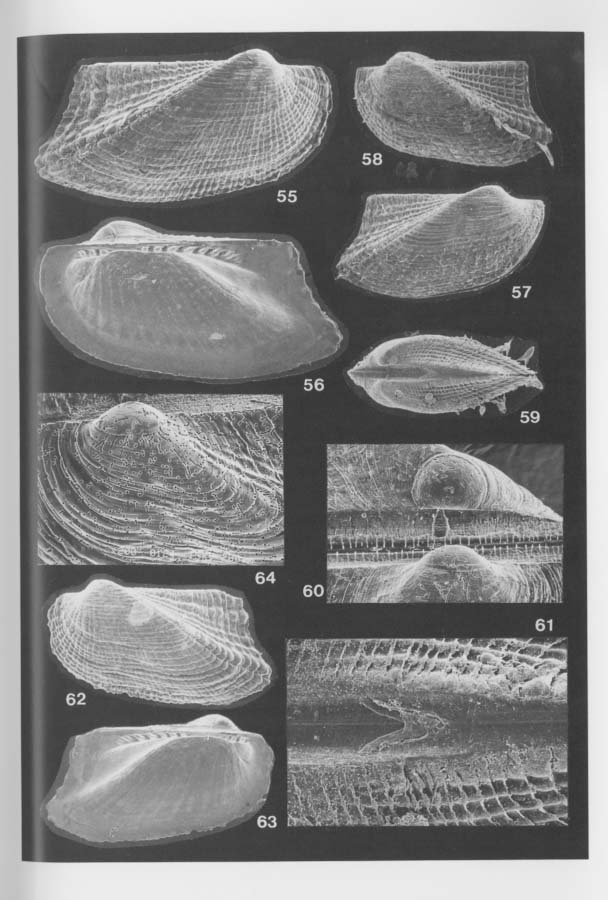Systematic Description
Bentharca excavata sp. nov.
|
  |
1992. Bentharca sp. E, Kase and Hayami, Jour. Moll. Studies, vol.58, p.448, listed.
Type and material.—Holotype: RM19390a, a living specimen, from the bottom sediments of "Cross Hole" of Irabu Islet, Miyako Islands. Paratypes: RM19383 (dead) from "Devil's Palace", RM19384 (dead) from "Fool's Palace", RM19385 (dead) from "Witch's House", RM19582 (living) from "Wall Cave", RM19580 (living) from "Toriike", RM19386 (dead) from "Black Hole", RM19581 (dead) from "Coral Hole" of Shimoji Islet. RM19387 (dead) from "Lunch Hole", RM19388 (living) from "W-arch", RM19389 (dead) from "L-arch", RM19390 (living) from "Cross Hole" of Irabu Islet. RM19391 (living) from "Shodokutsu" of Ie Islet.
Diagnosis.—Small species of Bentharca, characterized by reddish shell, rounded carina, excavated posterior area with frequently auriculate postero-dorsal end and deeply concave posterior margin, finely cancellate sculpture on flank, and weakly rimmed Pd I.
Description.—Shell scarcely exceeds 4.0 mm in length, scarlet or reddish brown in color, subtrapezoidal, about 1.8 times longer than high, moderately inflated. Posterior area delimited by rounded carina, remarkably excavated and often auriculated. Posterior margin deeply concave, almost rectangularly meeting dorsal margin. Ventral margin slightly concave in the middle or nearly straight. Umbo prosogyrous, incurved, located about one-fifth of dorsal margin from anterior end. Flank and posterior area similarly marked with cancellate sculpture consisting of fine commarginal lamellae and numerous radial ribs. No distinct marginal crenulations except in posterior area. Internal surface striated radially. Cardinal area moderate in breadth, vertically striated; alivincular ligament persistent throughout growth, while duplivincular ligament is only incipiently developed. Anterior teeth granular, about three in number; posterior teeth about seven, relatively strong and transversely crenulated. A wide edentulous area present in posterior portion of hinge plate. Pd I normal in shape, nearly smooth but with slightly elevated rim, ranging 173-183 µm in maximum diameter; Pd II not discriminated.
Remarks.—The present species was found alive on both the sediment surface and cave walls. It is characterized and readily distinguishable from other cave arcids by the deeply excavated and often auriculated posterior area, reddish coloration and finely cancellated surface. The persistent primary fibrous ligament and incipient duplivincular ligament are well observed in the holotype specimen (Figures 59-61). Not only the external but also the internal surface of living specimens is scarlet or reddish brown. The coloration seems to remain long in dead specimens.
Bentharca rubrotincta Kuroda and Habe, 1958, in Habe (1958: 252) reveals similarly cancellate sculpture and reddish coloration of shell, but its posterior part is not so deeply excavated. Although the illustration of that species first appeared in Habe (1961b, pl.49, fig.6), the lectotype has not been designated. The shell of B. rubrotincta commonly exceeds 8mm in length and is much larger than that of the present species (or any other species of Bentharca described here).
Distribution.—Common in many sublittoral caves of Ie, Shimoji and Irabu Islets of the Ryukyu Islands.